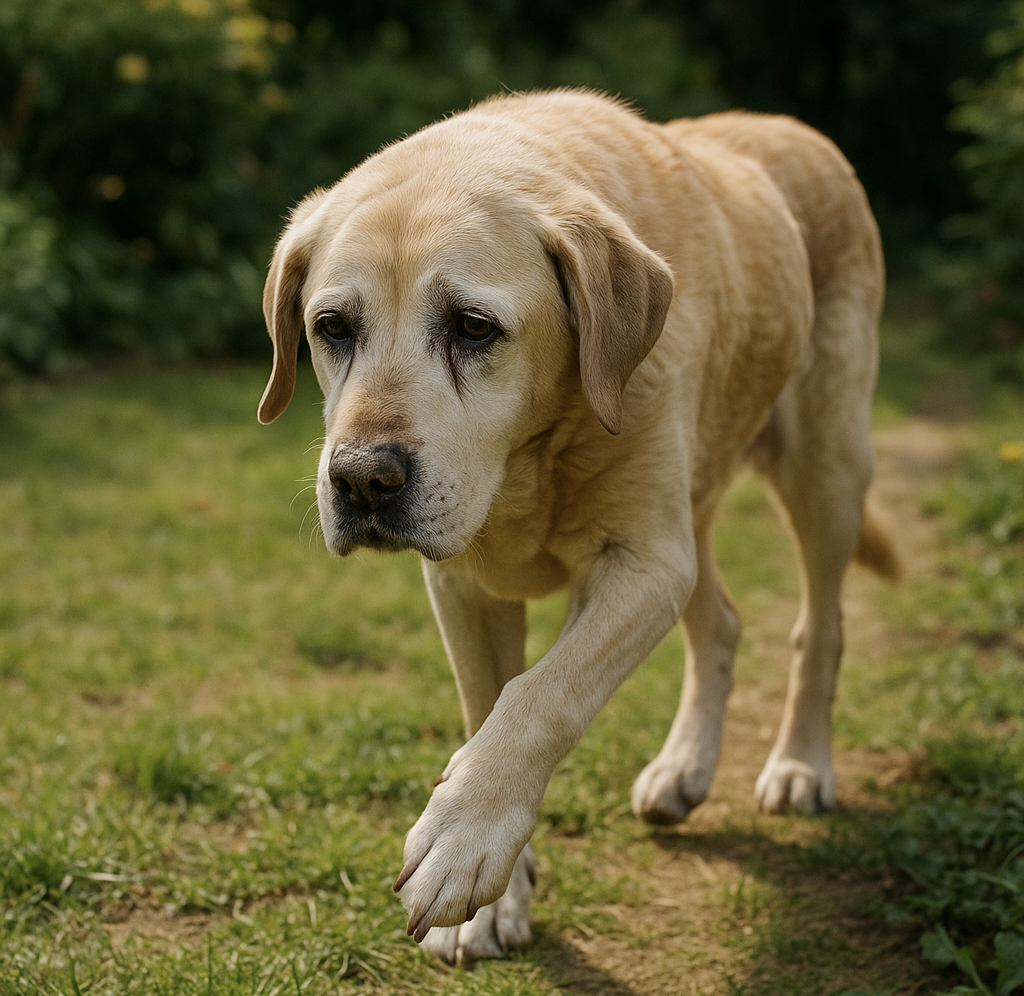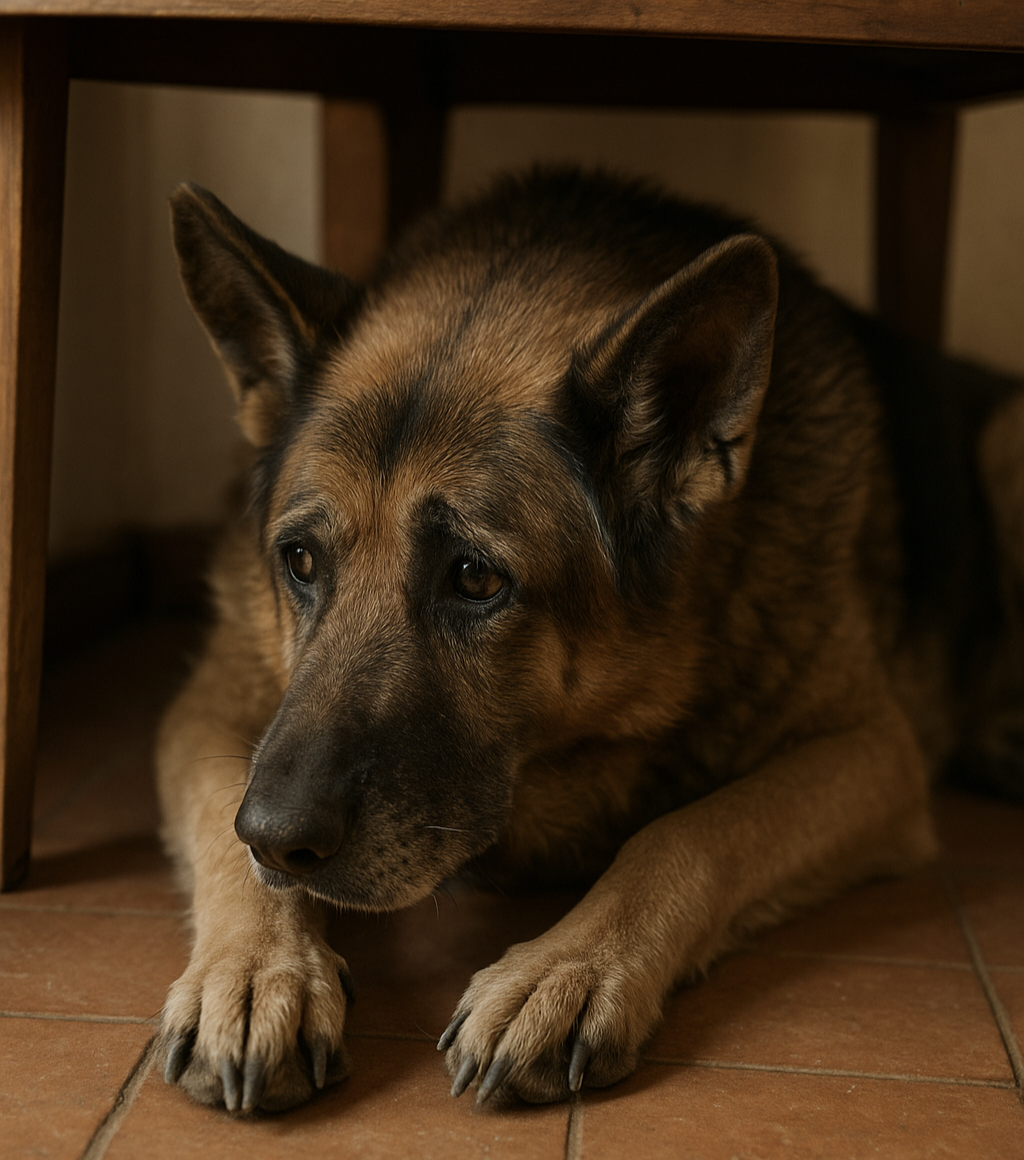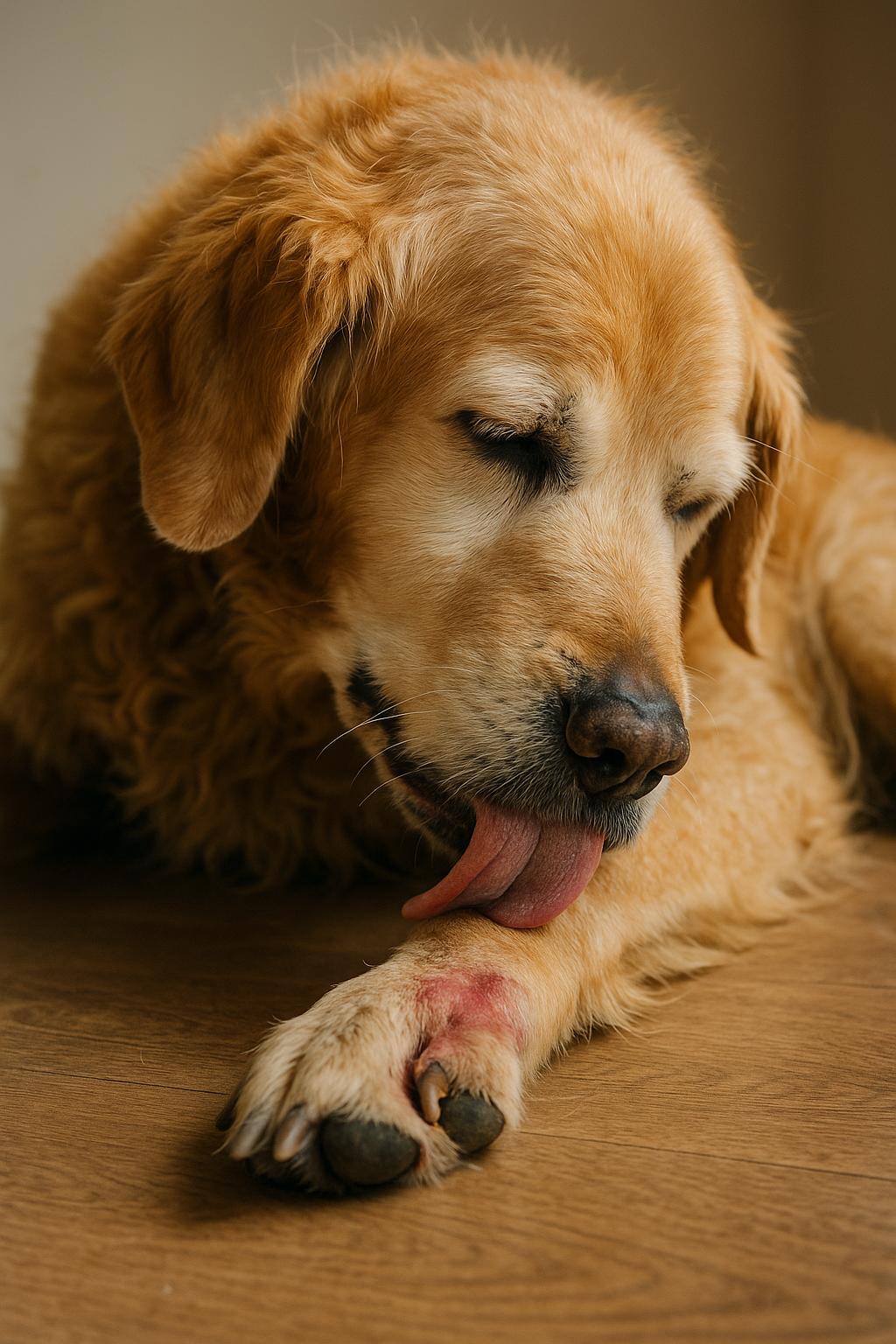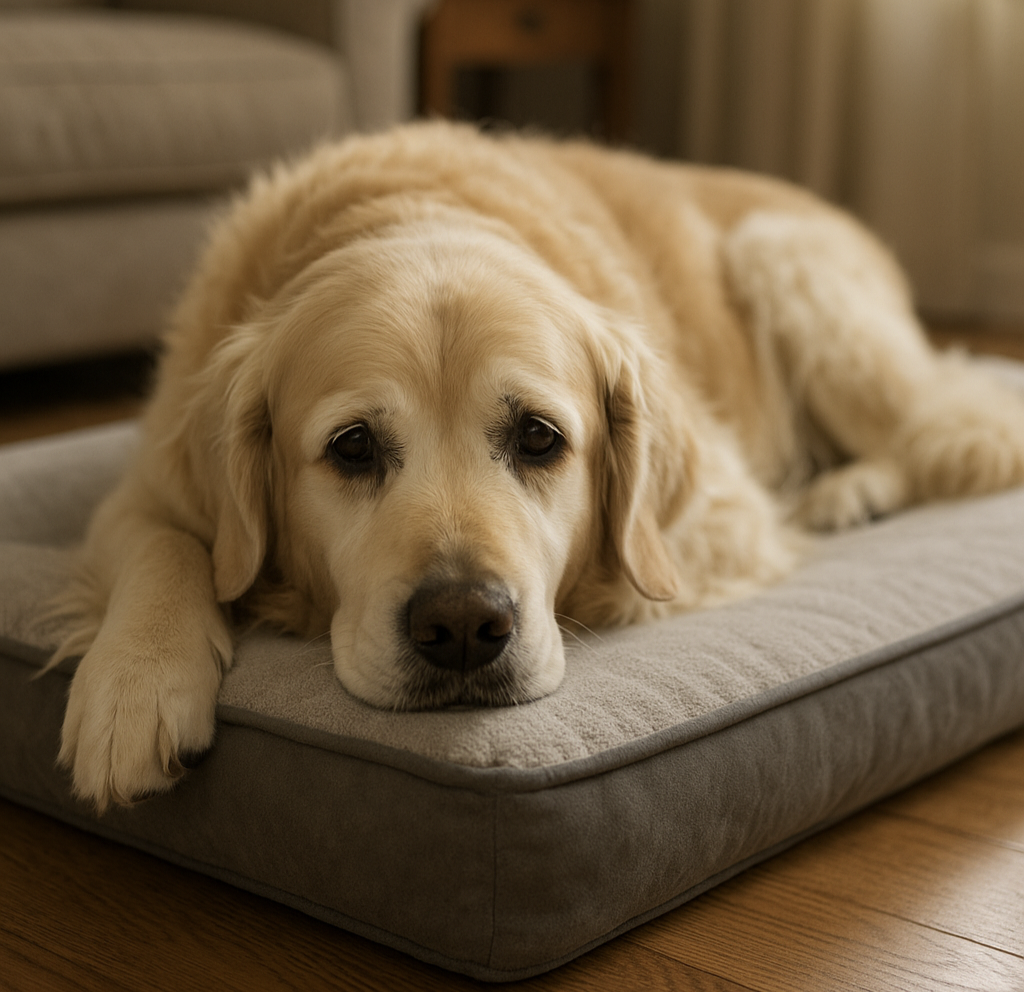Table of Contents
Introduction
early signs your senior dog is in pain
Senior dogs are beloved members of our families. As they age, their needs change — and unfortunately, they can experience pain that often goes unnoticed. Many owners assume signs of pain are just part of “getting old,” but that misunderstanding can lead to prolonged suffering.
10 Early Signs Your Senior Dog Might Be in Pain
If you’ve ever searched, “how do I know if my senior dog is in pain?”, you’re not alone. This article will guide you through 10 early signs your senior dog might be in pain, how to recognize these subtle changes, and what to do next.
Let’s help your furry friend live their best life — comfortably and pain-free.
1. Limping or Difficulty Walking

Signs of arthritis in older dogs
Does your dog hesitate before getting up? Do they limp after sleeping or avoid stairs altogether?
These are hallmark signs of arthritis in senior dogs, one of the most common causes of pain. Osteoarthritis, hip dysplasia, and degenerative joint disease are frequent culprits in aging dogs.
What to watch:
- Slow rising after naps
- Limping, especially after exercise
- Stiffness or awkward walking
What to do:
- Provide orthopedic bedding
- Add joint supplements like glucosamine or MSM
- Consult your vet about anti-inflammatory medication or laser therapy
🔗 Related: How to Treat Arthritis in Senior Dogs
2. Change in Behavior or Mood

Behavioral signs your dog is in pain
Your once-friendly pup is now snapping or hiding under the bed — why?
Pain often causes behavioral changes. A senior dog that’s hurting may become anxious, grumpy, or distant. They may growl when touched in a sore area or withdraw from family activity.
Watch for:
- Increased aggression or growling
- Avoiding touch or petting
- Sudden clinginess or isolation
What to do:
- Avoid stressing or scolding your dog
- Try calming environments
- Visit your vet to rule out chronic pain conditions
3. Loss of Appetite or Dropping Food
senior dog refuses to eat but acts normal
If your senior dog isn’t finishing meals or is dropping kibble, don’t ignore it. Dental disease is a common — and painful — issue in older dogs. Infections, abscesses, or worn teeth can make eating uncomfortable.
Symptoms to spot:
- Avoids crunchy treats or food
- Chews on one side of the mouth
- Drools more than usual
Next steps:
- Offer soft or wet food
- Schedule a dental exam and cleaning
- Use vet-recommended dental chews or rinses
4. Whimpering, Yelping, or Increased Vocalization
Why is My Old Dog Whining at Night
Vocal signs — like whining, yelping, or howling — can be a direct expression of pain, especially when lying down or being touched. If your dog becomes more “talkative” than usual, it may be their way of asking for help.
Common causes:
- Joint or back pain
- Digestive discomfort
- Injury or inflammation
What to do:
- Track when the vocalization occurs (e.g., at night, after walks)
- Avoid touching painful areas
- Get a vet exam to identify the source
5. Difficulty Sleeping or Restlessness at Night
Senior dog restless at night pacing
Is your dog circling the room or constantly changing positions overnight? Dogs in pain often can’t find a comfortable sleeping position.
You might notice:
- Pacing or circling
- Shaking or trembling at rest
- Whining during sleep
Solutions:
- Use a calming pheromone diffuser
- Try a memory foam orthopedic bed
- Check for pain triggers (e.g., arthritis, GI distress)
6. Excessive Licking, Chewing, or Biting
Dog Licking Paw constantly arthritis
Dogs instinctively lick or chew at areas that hurt. A senior dog licking a specific leg, hip, or side may be trying to ease pain — often due to arthritis or neuropathy.
Warning signs:
- Bald patches or sores
- Licking the same area repeatedly
- Chewing paws, joints, or flanks
Treatment options:
- Use a cone or anti-lick sleeves
- Explore laser therapy, acupuncture, or pain relievers
- Rule out skin infections or allergies
7. Shaking, Trembling, or Shivering

Senior dog trembling while lying down
Not all shivering is due to cold. If your senior dog trembles while resting or walking, they may be in discomfort. Causes include back pain, IVDD (disc disease), or abdominal pain
Look for:
- Shaking when touched
- Tense muscles
- Avoiding movement
What to try:
- Keep your dog warm and calm
- Document the frequency and context
- Ask your vet about muscle relaxants or anti-inflammatories
8. Changes in Posture or Gait
Dog Walking with Arched back or hunched
A hunched posture can signal abdominal pain or spinal discomfort. Dogs may also walk with stiff or straightened hind legs to avoid moving a painful joint.
Symptoms:
- Arched back
- Tail tucked tightly
- Head held lower than usual
Take action:
- Minimize movement and stress
- Offer warm compresses (only if vet-approved)
- Book a physical exam with your vet
9. Reluctance to Be Touched or Picked Up
Dog Flinches when touched in one spot
If your dog flinches, growls, or runs away when touched — especially in specific areas — that’s a major red flag for pain. The abdomen, hips, neck, and back are frequent zones of discomfort in older pets.
What it might mean:
- Herniated discs
- Tumors or inflammation
- Neurological pain
Solutions:
- Don’t force handling
- Use harnesses instead of collars
- Let your vet assess possible pain zones
10. Accidents in the House or Urination Problems
Senior dog suddenly peeing indoors
Pain can interfere with a dog’s ability to control their bladder or bowel movements. For example, arthritis may make squatting painful, or spinal issues could reduce nerve control.
Signs to note:
- Accidents inside after being house-trained
- Straining or vocalizing during urination
- Blood in urine or feces
Next steps:
- Rule out a urinary tract infection (UTI)
- Ensure potty breaks are more frequent
- Consider mobility support (e.g., ramps)
Common Causes of Pain in Senior Dogs
- Osteoarthritis and degenerative joint disease
- Hip or elbow dysplasia
- Dental infections or abscesses
- Cancer or tumors
- Spinal disc problems
- Bladder stones or urinary infections
- Skin infections or allergies
- Nerve pain or muscle strain
🔎 When to See a Veterinarian
Don’t wait if you notice:
- Sudden limping
- Reluctance to eat or drink
- Personality changes
- Signs of fever or swelling
🩺 Veterinary options include:
- X-rays or ultrasound
- Bloodwork or urine tests
- Pain relievers or anti-inflammatories
- Senior-specific treatment plans
🏡 How to Help a Senior Dog in Pain at Home
early signs your senior dog is in pain
✅ Use these at-home care tips:
- Provide elevated food and water bowls
- Use orthopedic bedding and non-slip rugs
- Try heat therapy or massage (vet-guided)
- Maintain a healthy weight with diet and low-impact walks
- Add joint supplements (consult vet)

Dogs don’t hide pain to deceive us—they do it because love means staying present.” — Dr. Gina Singleton, DVM
📥 Free Download: Senior Dog Pain Checklist (PDF)
FAQs
Q: Is pain in senior dogs always obvious?
A: No, dogs hide pain well. Subtle behavior or mobility changes can be major red flags.
Q: Can I give my dog human painkillers?
A: No. Never give aspirin, ibuprofen, or acetaminophen without vet guidance — they can be toxic.
Q: Are supplements enough to treat joint pain?
A: Supplements like glucosamine help but may not be enough alone. Always pair them with vet care.
Q: Can dental issues cause serious pain?
A: Yes. Dental infections are painful and can lead to organ damage if left untreated.
Q: How do I know if my old dog is in pain?
A: Look for subtle signs like limping, licking, behavior changes, or appetite loss. Dogs often hide pain.
Q: Can I give my senior dog aspirin or Tylenol?
A: No! Human medications can be toxic to dogs. Always consult your vet.
Q: Is pain normal in old dogs?
A: No — aging may increase risk, but pain is never “just old age” and should always be treated.
Conclusion
Recognizing the early signs your senior dog is in pain could be the key to improving — or even saving — their life. From limping and licking to behavior shifts and nighttime restlessness, your dog is communicating the best they can.
You are your dog’s best advocate. If something seems off, trust your instincts and talk to your vet. Early intervention makes all the difference.
📩 Subscribe to SeniorPawsGuide.com to get weekly senior pet care tips, product reviews, and health advice straight to your inbox.







2 thoughts on “10 Early Signs Your Senior Dog Might Be in Pain”